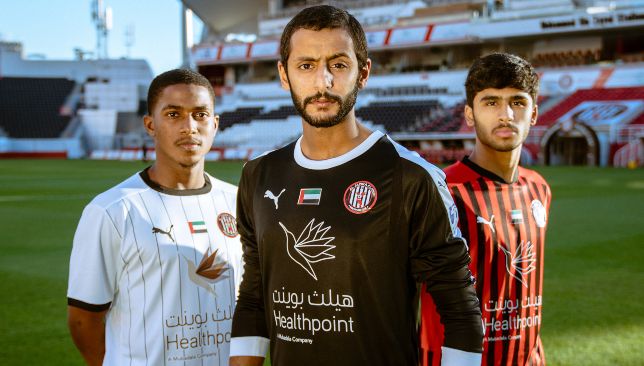Inspiration has never been in short supply for Milos Kosanovic.
The, now, Al Jazira centre-back came through at Serbia’s time of plenty with defenders.
Nemanja Vidic reinforced Manchester United’s rearguard with a warrior spirit during an abundant period of success, when the 30-year-old was establishing himself in the professional game. Miroslav Djukic cut an elegant figure in La Liga at Deportivo La Coruna and Valencia before then, with Mladen Krstajic excelling in the Bundesliga.
But anyone witnessing Kosanovic wind up for a fierce free-kick will soon guess the identity of his true national idol. Just ask Ittihad Kalba goalkeeper Jamal Abdullah, who felt the full force in this month’s Arabian Gulf Cup-opener.
“100 per cent [Sinisa] Mihajlovic,” said the Serbia international about his predecessor who whipped in more than 60 set-pieces from 1986-2006, including a hat-trick of them for Lazio against former employers Sampdoria. “He was always my example when I was a kid.
“And a lot kids also follow Mihajlovic during the age when he was at the top and scoring a lot of goals as a defender.
“As a kid, I was kicking free kicks like him. He was the example I was following.
“Later on, of course, what Nemanja Vidic did at Manchester United was amazing. They raised Serbian football and every Serbian defender works in a different way because of these guys, so I am happy that they’re coming from my country and represented Serbia in a good way.”

(PUMA).
Kosanovic’s journey has taken him from the village of Conoplja in north-western Serbia, to Mohammed bin Zayed Stadium in distant Abu Dhabi.
He, there, helped Jazira go from 2018/19’s seventh-worst defence to 2019/20’s second best. A tally of 97 interceptions, the Arabian Gulf League’s fourth highest, played a big part in this improvement.
Refined ability on the ball, plus providing essential guidance to UAE prospect Khalifa Al Hammadi, is key in ex-Ajax coach Marcel Keizer’s possession-heavy system. Kosanovic’s 1,157 passes, according to Wyscout, was the fourth most last term and an accuracy of 91.9 per cent was only bettered by seven others.
This contribution propelled Jazira into third, prior to March’s postponement because of coronavirus.
Stops along the way for this cultured figure, who speaks “five or six languages”, included Poland, Turkey and Belgium, where he was plucked from Standard Liege in August 2019. There is also September 2015’s solitary senior cap.
“I always dreamt of playing for the national team and I did it,” Kosanovic, clad in PUMA for Jazira’s 2020/21 kit launch, says of a 2-1 friendly defeat to star-studded France in Bordeaux.
“I was only watching [Karim] Benzema on television and then suddenly I was playing against him. So that’s one dream that came true.”
Serbia, or in its various former guises as Yugoslavia, has long punched above its weight when it comes to developing elite footballers. A population estimated at less than 9 million has produced the likes of Sergej Milinkovic-Savic, Nemanja Matic, Dusan Tadic and Luka Jovic.
It also claimed the 2015 U-20 World Cup, defeating Brazil 2-1 in the final.
Their rich lineage includes Dragan Stojkovic, Dejan Stankovic, Branislav Ivanovic, Vladimir Jugovic, Mateja Kezman and Savo Milosevic. Among many others.
This situation is repeated across the Balkans, which now acts as a byword for technical proficiency. From Luka Modric’s Croatia, Bosnia & Herzegovina’s Miralem Pjanic and Bulgaria’s Hristo Stoichkov, to Slovenia’s Jan Oblak.
How does this region keep up its bountiful production line?
“There are a lot of football school and academies,” Kosanovic replies. “Coaches are doing a really good job there.
“I think that’s not only the case in Serbia but in the whole Balkan region, like Macedonia, and Slovenia. There is plenty of talent.
“The only thing that’s not good is that some leave Serbia too early on. Some to chase the money and others due to private problems.
“I think this is the only thing that isn’t good for these young players, especially when they go to Europe early and end up not playing and then coming back to Serbia.
“There are a lot of young talented players and you can see that in the football world where there are a lot of Serbian players. We are producing a lot of good players.”

(PUMA).
Many of the Emirates’ finest talents can be found at the MBZ.
From seasoned performers who’ve been the scourge of Asian defences, such as 2016 AFC Player of the Year Omar Abdulrahman and 63-goal Whites top scorer Ali Mabkhout, to Grade A-prospects Al Hammadi and Mohammed Al Attas.
Kosanovic has gained invaluable insight into what is required to prosper at the highest level. What advice would he give the UAE’s next generation?
He says: “The UAE has a lot of good young players that just need to be aware that they need to work a lot to become real professionals. In each club there’s plenty of talent, but they just need to follow the task and what they put in their head if they want to be the new Amoory [Abdulrahman’s nickname] or Ali Mabkhout, or something like that.
“They just need to work for this dream to come true. They need to listen to their coaches, and I hope we will see a lot of young rising stars in UAE football.”
The AGL boasts a plethora of feared strikers for centre-backs to deal with.
Naturalised UAE international Sebastian Tagliabue has 152 top-flight goals to his name since 2013, Sharjah’s Welliton is a proven proposition across Europe, the emergent Joao Pedro appears poised to fire Bani Yas into an unlikely title charge and ex-Germany Under-21 target man Peniel Mlapa is a revelation for Kalba.
But a multifaceted Togo star who “has everything” shines brightest.
“Maybe [Kodjo Fo-Doh] Laba from Al Ain, because he has everything,” says Kosanovic when asked to pick out his most-dangerous opponent.
“He’s strong, powerful, fast and skilful. He has a little bit of everything.
“It’s not easy to face a player like this where you need to watch out for all the details.
“Sometimes you have a player who is small and only runs in the space and doesn’t ask for the ball. Laba is different – he has everything, looking in the space and to keep the ball.”
A torrent of goals greeted 2020/21’s start after the seven-month stoppage. Of the 29 scored in opening weekend, however, Jazira conceded just once during their stalemate at Al Nasr.
Injury forced Kosanovic’s removal after 22 minutes at Al Maktoum Stadium. He is, though, raring to return for the “big challenge” of sending 2016/17 champions Jazira back to the summit.
He says: “I am always happy when we finish the game conceding zero goals. This is the most important thing for a defender.
“I am also happy when I can help young payers to show them what I learned in Europe so we can be complimentary on the pitch.
“The most important is to win the game and not concede. What we do going forward, if we score, is considered an extra but our job is to protect our goal.
“I am looking forward to this season, it is a big challenge, not only for me, but for all defenders to perform well.”
Milos Kosanovic was speaking on the photoshoot for Al Jazira’s 2020/21 PUMA kit launch. This is the first season that the Abu Dhabi based club have partnered with PUMA, with the Pride of Abu Dhabi wearing the new kit this weekend for the game against Ittihad Kalba. This season the first team has been wearing a limited edition PUMA kit which honours frontline heroes and will be gifted to those who have been supporting in the fight against COVID throughout the UAE. Fans will be able to purchase the new home and away kits in the official club store at Mohammed bin Zayed Stadium.